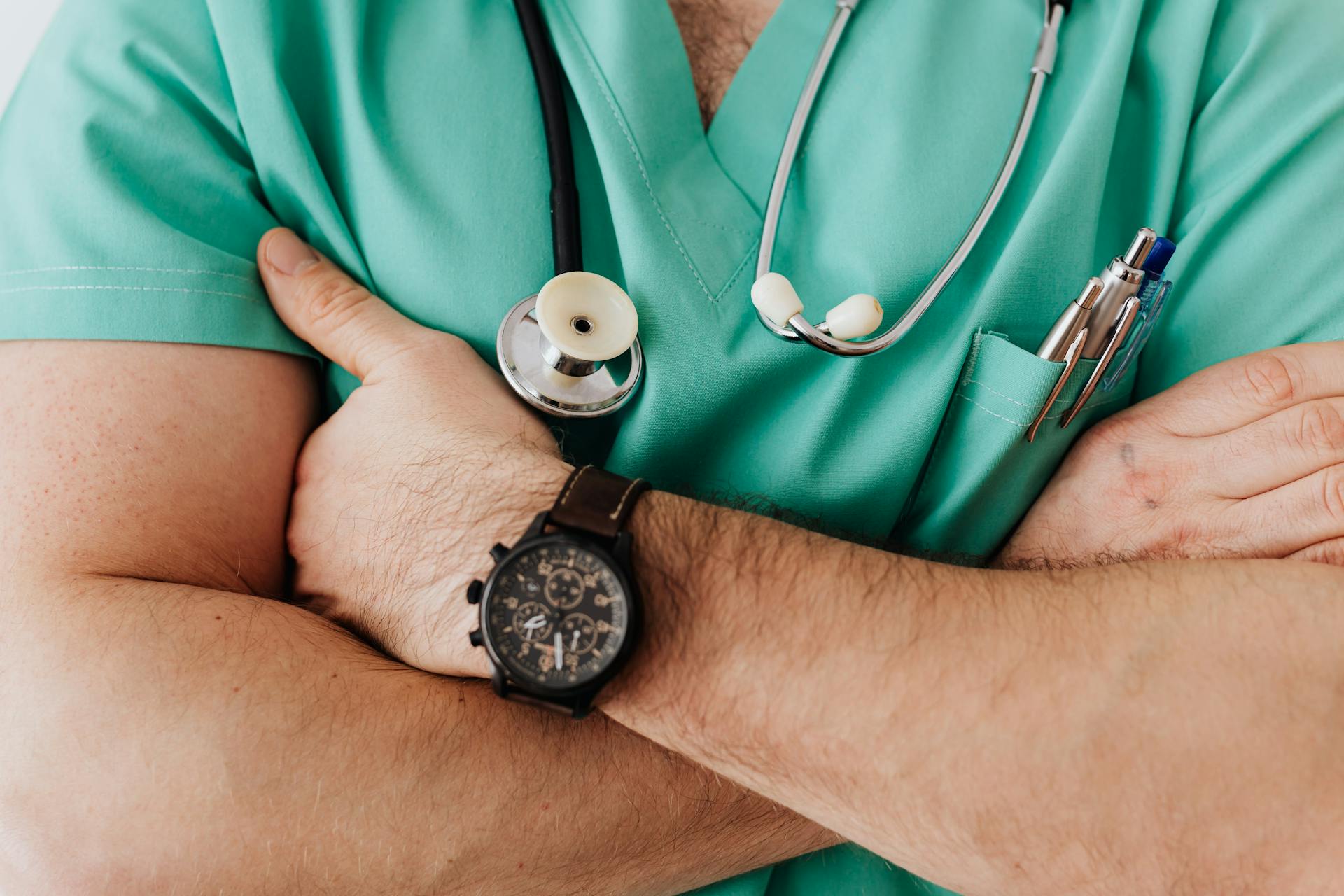
The Italian Health Insurance Card, also known as the Tessera Sanitaria, is a must-have for anyone living or working in Italy. It's a small card that grants you access to the country's public healthcare system.
You can obtain a Tessera Sanitaria by registering with the local health authority, called the Azienda Sanitaria Locale (ASL). Registration typically takes place within 30 days of arriving in Italy.
To register, you'll need to provide personal documents, such as a valid passport and proof of address. You may also need to undergo a medical checkup to determine your health status.
Expand your knowledge: Do I Need Disability Income Insurance
Who Is Eligible?
To be eligible for the Italian health insurance card, you must be a resident of Italy and registered with the SSN. Italian citizens, including those who have acquired citizenship through descent, marriage, or naturalization, are eligible for the Tessera Sanitaria.
EU citizens who reside in Italy for more than three months and are registered with the local registry office can also apply. Non-EU citizens with a valid residence permit are eligible, including those with work permits, family reunification permits, or study visas.
For another approach, see: Cigna Flex Spending Account Eligible Items
Family members of those enrolled in the SSN, including spouses and minor children, can also be covered under this system. To be eligible, you must meet one of these categories.
Here's a breakdown of the eligibility categories:
Application and Renewal
Applying for an Italian health insurance card, also known as a Tessera Sanitaria, is a straightforward process that varies slightly depending on where you live in Italy.
To apply for registration to the Italian National Health Service, you'll need to gather required documents, which include your identification, Codice Fiscale, proof of residence, and a completed application form.
If you're entitled to "Mandatory registration", you won't have to pay for registration, but if you're allowed to register voluntarily, you'll need to settle a yearly payment, which can be a lump sum or a variable amount depending on your income.
The cost of registration is calculated based on your income, with a fixed yearly lump sum of €387.34 for an annual income between €0 and €5,165.00, and a 7.5% rate for an income exceeding €5,165.00 up to €20,658.28.
Here's an interesting read: Do I Need Us Health Insurance If I Live Abroad
To renew your Italian Health Insurance Card, you'll need to bring the required documents to the ASL (Local Health Authority), including your passport, documents confirming the request for renewal of your permit to stay, your Codice Fiscale, and a certificate of residence.
If you're registered by choice, you'll also need to bring the receipt of the payment at the post office for the registration to the Italian National Health Service.
The renewal process is relatively simple, and your temporary registration will remain valid until the expiry of your permit to stay.
You can renew your health card at any time, but the payment for optional registration refers to the calendar year and cannot be split up.
Here's a summary of the required documents for renewing your health card:
- Passport
- Documents confirming the request for renewal of the permit to stay
- Codice Fiscale
- Certificate of residence
- Receipt of payment at the post office for the registration to the Italian National Health Service (if registered by choice)
Note that if you're entitled to "Mandatory registration", you won't have to pay for renewal, and your Tessera Sanitaria will remain valid until the expiry of your permit to stay.
Lost or Replacement Card
If you've lost your Tessera Sanitaria, you can ask for a duplicate online or at your ASL (Local Health Authority) or at any office of the Agenzia delle Entrate (Revenue Agency).
You can also get a duplicate at any office of the Agenzia delle Entrate (Revenue Agency).
Getting a duplicate is a relatively straightforward process, but it's essential to have the necessary documentation to avoid any delays.
To obtain a duplicate, you'll need to provide the required documents, which may include proof of identity and residency.
If this caught your attention, see: Hipaa Compliant Office Space
Costs and Exceptions
If you're entitled to "Mandatory registration" with the Italian National Health Service (SSN), you don't have to pay to register.
The cost of registering with the Italian National Health Service (SSN) varies depending on your income and registration type. For applicants with a gross income exceeding € 5165.00, the rate is 7.5% for amounts up to € 20,658.28, and 4% for amounts exceeding € 20,658.28.
The annual contribution is € 387.34 for an income between 0 and € 5165.00. If you don't have a personal income, the cost of the registration is calculated on that of the family you're dependent on.
Here's a breakdown of the costs for students and au pairs:
Keep in mind that the payment for optional registration refers to the calendar year and cannot be split up.
Application Costs
If you're entitled to "Mandatory registration" with the Italian National Health Service (SSN), you don't have to pay a thing.
The cost of registration varies depending on your income and status. For students and au pairs, it's a fixed yearly lump sum: € 149.77 for students and € 219.49 for au pairs.
The annual contribution for optional registration is calculated based on your gross income. If your income is between 0 and € 5165.00, it's a flat rate of € 387.34.
For income exceeding € 5165.00, the rate is 7.5% up to € 20,658.28, and 4% for amounts exceeding € 20,658.28 and up to € 51,645.69.
Here's a breakdown of the rates:
In any case, the payment for optional registration refers to the calendar year and cannot be split up.
Exceptions

In Lombardy, there was a unique document called the CRS-SISS that allowed people to make payments and access online government services. It had a smart chip and a magnetic stripe, and was aesthetically different from the national health insurance cards.
The CRS-SISS had its own special card reader and was available until the end of September 2013. People could use it to access online services, but it had to be activated by the individual.
The CRS-SISS was gradually replaced by the smart card version of the national health insurance card.
Here's an interesting read: Access Dental Insurance
Pharmaceutical Expenses
Pharmaceutical expenses can be deducted with the right documentation. From 1 January 2008, a new law came into force requiring a special receipt called the "scontrino fiscale parlante" for certifying medicines.
This receipt shows the amount and type of drugs purchased, making it easier to keep track of expenses. You'll also need to provide your health insurance card or Italian fiscal code card when buying medicine.
The receipt includes tax code reviews, which is a crucial detail for deducting expenses. It's essential to have all the necessary documentation to claim your pharmaceutical expenses.
Worth a look: Vaneck Pharmaceutical Etf
Sanitaria and Health Card
The Tessera Sanitaria is a must-have document for anyone living in Italy. It's the Italian Health Insurance Card that proves you're registered with the Italian National Health Service (SSN).
To get your Tessera Sanitaria, you'll need to gather a few documents, including your passport, valid permit to stay, and Codice Fiscale (Italian Tax Code). You'll also need to fill out a self-declaration of residency or place of abode.
You can pay a visit to the Local Health Authority office (ASL) to check the requirements and pay the annual fee. Just complete a postal order (Bollettino Postale) at the Post Office and keep the receipt.
The Tessera Sanitaria is a health card that includes a personal identification number and tax code. It's essential for accessing various services, including healthcare, filing taxes, and applying for other public services.
Here's a summary of the documents you'll need to get your Tessera Sanitaria:
- Passport
- Valid permit to stay or receipt
- Codice Fiscale (Italian Tax Code)
- Self-declaration of residency or place of abode
- Receipt of payment for registration from the Post Office (if required)
- Document confirming enrollment at a school or au pair contract (if applicable)
- Copy of all above documents
The Tessera Sanitaria is not required for seeing a private doctor, but it's essential for accessing public healthcare services, including general practitioners, hospital care, and prescription medications.
Frequently Asked Questions
How to get a medical card in Italy?
To get a medical card in Italy, you need to have a valid tax code and be registered with the Local Health Authority. You can then obtain your free Health Card through the Health Card System.
How to get tessera sanitaria in Italy as a student?
To get a tessera sanitaria in Italy as a student, you must be a resident and pay an annual fee of at least €700. Registration is done on a calendar year basis, from January 1st to December 31st.
Sources
- https://en.wikipedia.org/wiki/Italian_health_insurance_card
- https://www.doctorsinitaly.com/b/how-to-get-tessera-sanitaria/
- https://itamcap.com/blog/how-to-apply-for-a-tessera-sanitaria-italian-health-insurance-card/
- https://www.vademecumitalia.com/the-italian-health-card-the-european-health-insurance-card-and-the-health-cardnational-services-card/
- https://italiahello.it/en/articolo/tessera-sanitaria-national-health-insurance-card/
Featured Images: pexels.com


